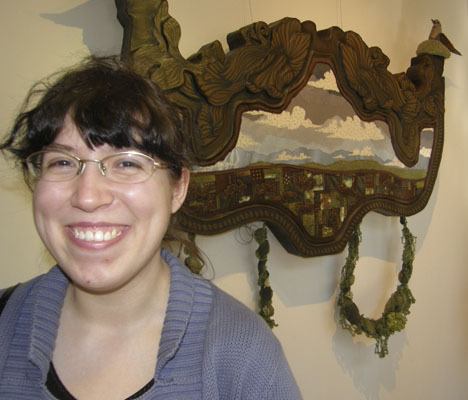Grace Willard finds inspiration everywhere her feet take her, in weed wild lots and cultivated plots, along tidy streets and untidy shores.
For an artist with imagination like Willard’s, it’s a challenge to climb out of bed in the morning without stubbing a toe over the possibilities.
“I’m a pedestrian,” said Willard, “and I spend a lot of time walking and taking the bus. It’s amazing the amount of biological diversity in your backyard, the plants, the animals.”
Willard takes what she finds and shapes it into works of fiber art that force the viewer to look closely. Her artwork fuses unlikely and seemingly incompatible mediums, materials and imagery, from delicate ink-drawn representations of sea urchins and sea life on homemade paper to large, paper mache sculptures festooned with paint, quilted fabrics and crocheted thread.
Willard, 25, will demonstrate how to make paper mache relief sculptures at the ArtRageous: Artists in Action Fair on Saturday at Les Gove Park. Through July 31, a sampling of her fiber art also may be found alongside the works of Seattle artist Ann Maki in the Auburn City Hall Gallery, at 25 W. Main St.
Willard began drawing as a small child, and when she was 14 volunteered at the Washington County Museum of Fine Arts in West Virginia. Being in a museum, surrounded by the works of fine artists, turned the young girl’s head around.
“At that point I realized that could be my artwork, that could be me,” Willard said. “Basically. I started taking art very seriously, and I enrolled at our local technical school in graphic design. It was not quite what I wanted to do. I wanted more training.”
At 17, Willard left West Virginia and enrolled in the Columbia College of Art and Design in Columbus, Ohio.
“It was an amazing program. I learned a lot of technique through studying art history and focused on drawing and painting,” she said. “One thing I found was that not a lot of women painters were represented. I started looking into women’s art work, especially women’s art work from West Virginia. There was a lot from Paris, France and New York but not a lot from West Virginia.”
Willard earned her bachelor’s degree in fine arts and began making her own paper. She liked to walk about her neighborhood and collect.
“I would go to the park, gather up all the old dry leaves, take them back to my studio and make them into paper. Then I would draw on the paper with technical pens,” she said. “That was a good experience. Once I got into fiber art more, I began embroidering because I wanted to crochet around it. Those works are very, very fragile; you need to take special care that you frame them very carefully. I felt I needed art work that was more robust, so I started making sculptural works.
“The sculptural pieces I make with corrugated plastic and old signs and the litter I find along the road,” she added. “I take the corrugated plastic and paper mache over it, and that makes it very rigid and hard. I get paper mache stuff from the waste paper in recycle bins.”
Public reaction has been positive, Willard said.
“When people find out I make art of plastic and old signs and litter, they are very interested and supportive,” she said. “Many people here strive to be environmentally responsible. I am happy to find a way to reallocate or reuse it. It appeals to me, and I am very happy about it.”



